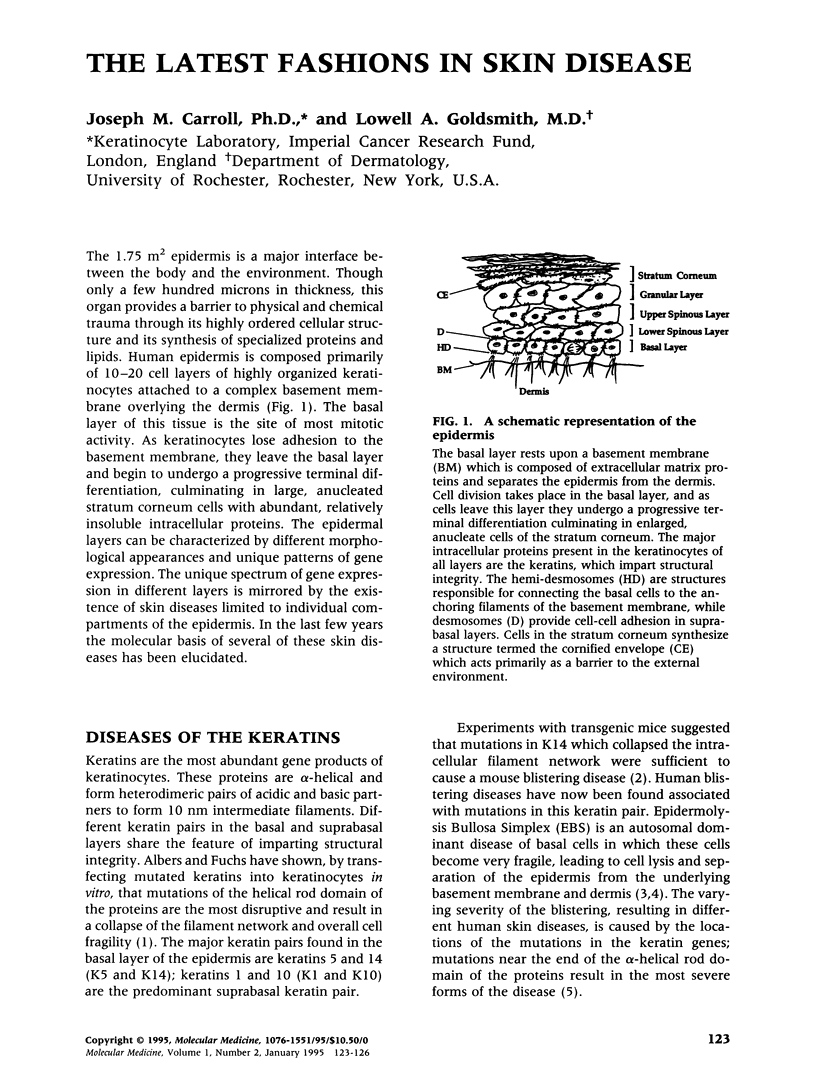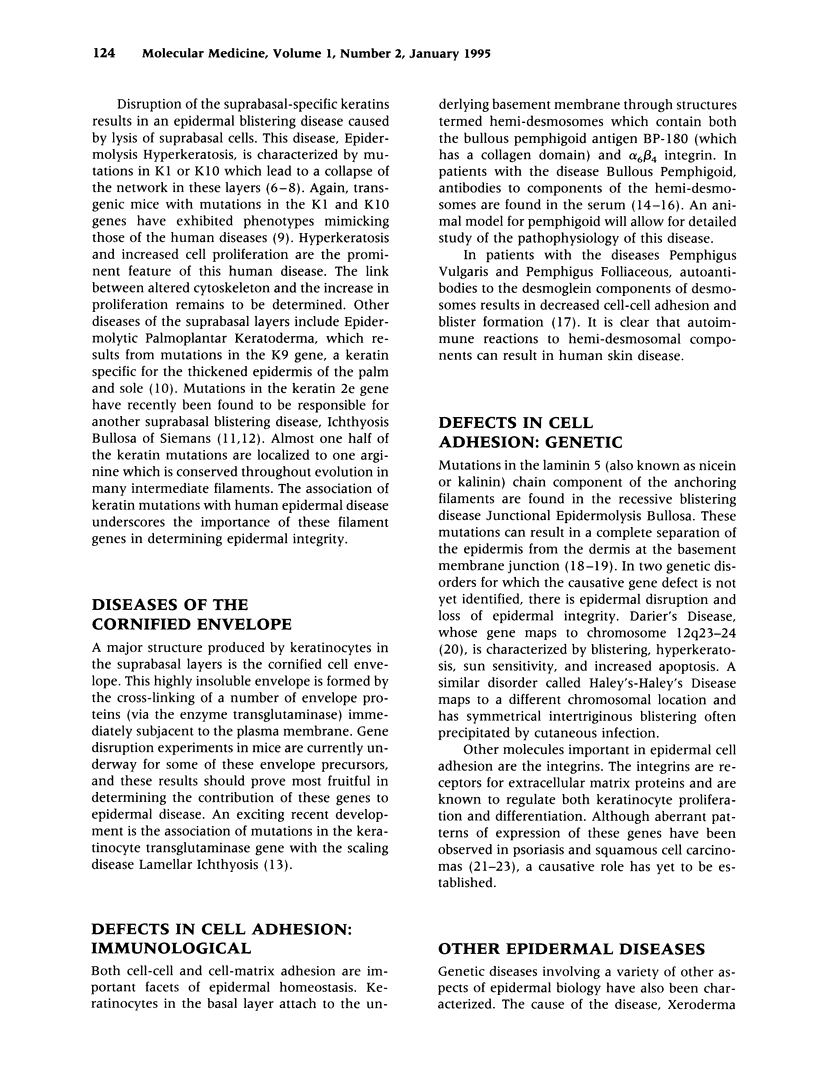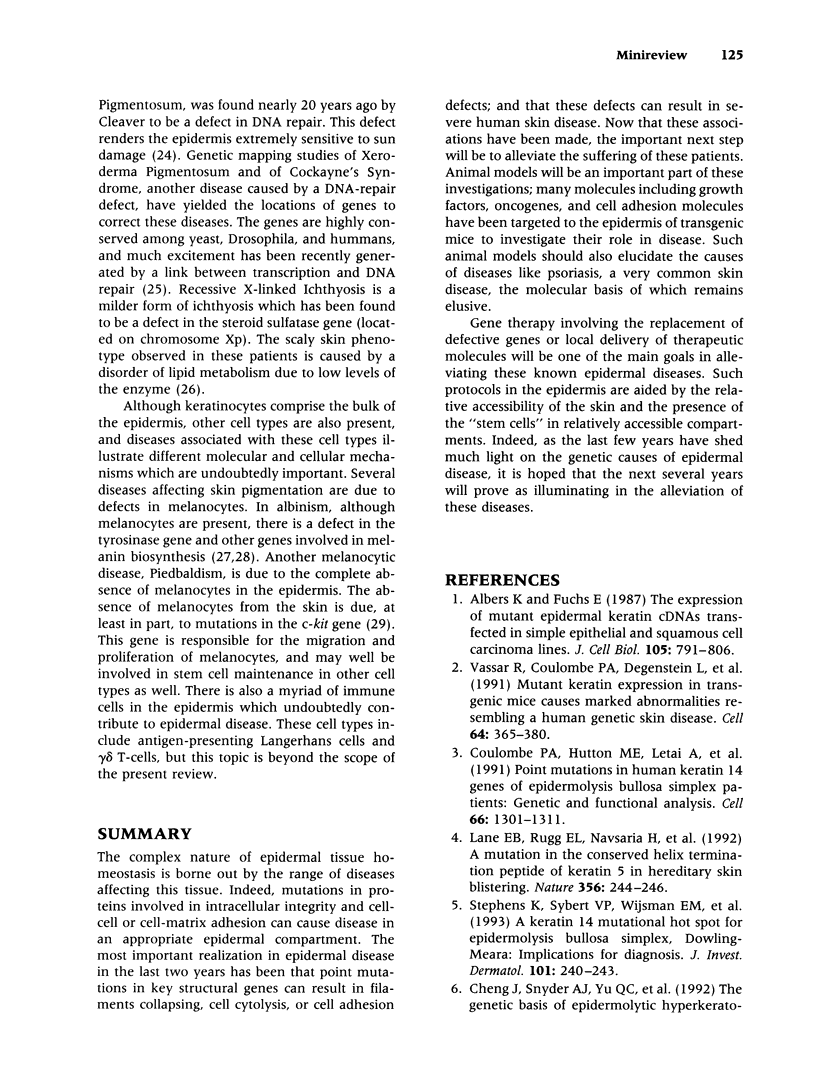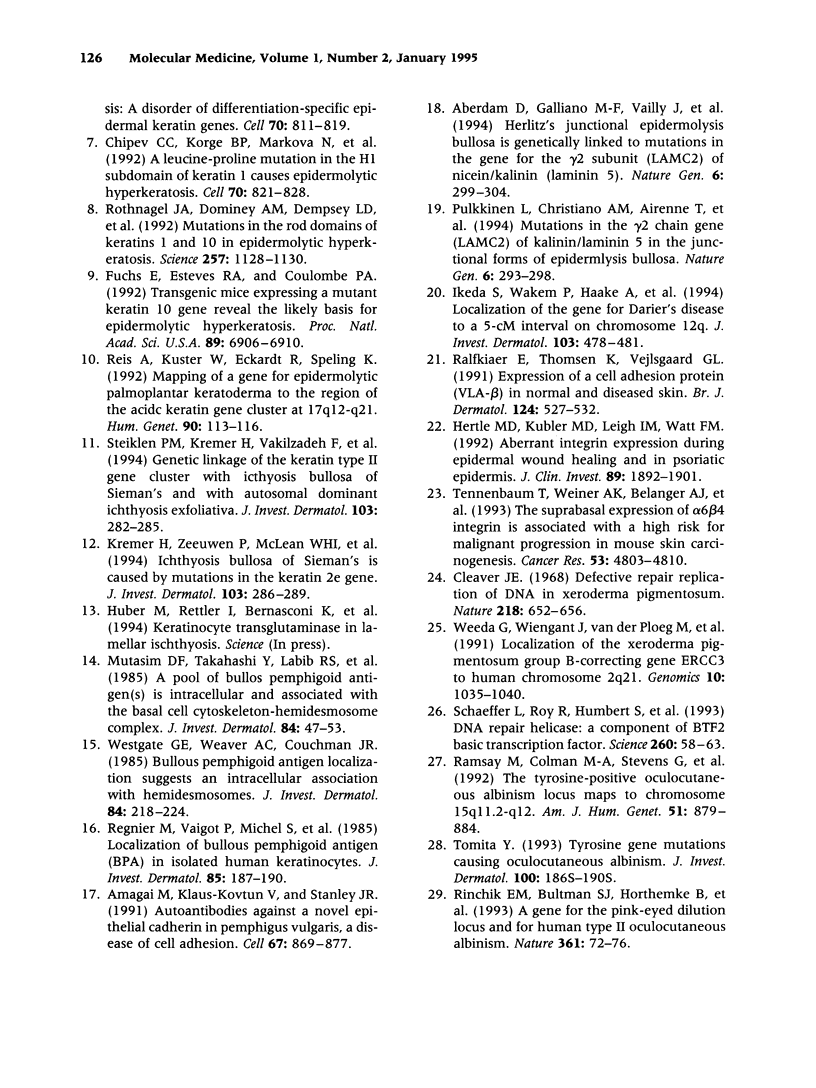Abstract
The complex nature of epidermal tissue homeostasis is borne out by the range of diseases affecting this tissue. Indeed, mutations in proteins involved in intracellular integrity and cell-cell or cell-matrix adhesion can cause disease in an appropriate epidermal compartment. The most important realization in epidermal disease in the last two years has been that point mutations in key structural genes can result in filaments collapsing, cell cytolysis, or cell adhesion defects; and that these defects can result in severe human skin disease. Now that these associations have been made, the important next step will be to alleviate the suffering of these patients. Animal models will be an important part of these investigations; many molecules including growth factors, oncogenes, and cell adhesion molecules have been targeted to the epidermis of transgenic mice to investigate their role in disease. Such animal models should also elucidate the causes of diseases like psoriasis, a very common skin disease, the molecular basis of which remains elusive. Gene therapy involving the replacement of defective genes or local delivery of therapeutic molecules will be one of the main goals in alleviating these known epidermal diseases. Such protocols in the epidermis are aided by the relative accessibility of the skin and the presence of the "stem cells" in relatively accessible compartments. Indeed, as the last few years have shed much light on the genetic causes of epidermal disease, it is hoped that the next several years will prove as illuminating in the alleviation of these diseases.
Full text
PDF



Selected References
These references are in PubMed. This may not be the complete list of references from this article.
- Aberdam D., Galliano M. F., Vailly J., Pulkkinen L., Bonifas J., Christiano A. M., Tryggvason K., Uitto J., Epstein E. H., Jr, Ortonne J. P. Herlitz's junctional epidermolysis bullosa is linked to mutations in the gene (LAMC2) for the gamma 2 subunit of nicein/kalinin (LAMININ-5). Nat Genet. 1994 Mar;6(3):299–304. doi: 10.1038/ng0394-299. [DOI] [PubMed] [Google Scholar]
- Albers K., Fuchs E. The expression of mutant epidermal keratin cDNAs transfected in simple epithelial and squamous cell carcinoma lines. J Cell Biol. 1987 Aug;105(2):791–806. doi: 10.1083/jcb.105.2.791. [DOI] [PMC free article] [PubMed] [Google Scholar]
- Amagai M., Klaus-Kovtun V., Stanley J. R. Autoantibodies against a novel epithelial cadherin in pemphigus vulgaris, a disease of cell adhesion. Cell. 1991 Nov 29;67(5):869–877. doi: 10.1016/0092-8674(91)90360-b. [DOI] [PubMed] [Google Scholar]
- Chipev C. C., Korge B. P., Markova N., Bale S. J., DiGiovanna J. J., Compton J. G., Steinert P. M. A leucine----proline mutation in the H1 subdomain of keratin 1 causes epidermolytic hyperkeratosis. Cell. 1992 Sep 4;70(5):821–828. doi: 10.1016/0092-8674(92)90315-4. [DOI] [PubMed] [Google Scholar]
- Cleaver J. E. Defective repair replication of DNA in xeroderma pigmentosum. Nature. 1968 May 18;218(5142):652–656. doi: 10.1038/218652a0. [DOI] [PubMed] [Google Scholar]
- Coulombe P. A., Hutton M. E., Letai A., Hebert A., Paller A. S., Fuchs E. Point mutations in human keratin 14 genes of epidermolysis bullosa simplex patients: genetic and functional analyses. Cell. 1991 Sep 20;66(6):1301–1311. doi: 10.1016/0092-8674(91)90051-y. [DOI] [PubMed] [Google Scholar]
- Fuchs E., Esteves R. A., Coulombe P. A. Transgenic mice expressing a mutant keratin 10 gene reveal the likely genetic basis for epidermolytic hyperkeratosis. Proc Natl Acad Sci U S A. 1992 Aug 1;89(15):6906–6910. doi: 10.1073/pnas.89.15.6906. [DOI] [PMC free article] [PubMed] [Google Scholar]
- Hertle M. D., Kubler M. D., Leigh I. M., Watt F. M. Aberrant integrin expression during epidermal wound healing and in psoriatic epidermis. J Clin Invest. 1992 Jun;89(6):1892–1901. doi: 10.1172/JCI115794. [DOI] [PMC free article] [PubMed] [Google Scholar]
- Ikeda S., Wakem P., Haake A., Ewing N., Polakowska R., Sarret Y., Trattner A., David M., Shohat M., Schroeder D. W. Localization of the gene for Darier disease to a 5-cM interval on chromosome 12q. J Invest Dermatol. 1994 Oct;103(4):478–481. doi: 10.1111/1523-1747.ep12395577. [DOI] [PubMed] [Google Scholar]
- Kremer H., Zeeuwen P., McLean W. H., Mariman E. C., Lane E. B., van de Kerkhof C. M., Ropers H. H., Steijlen P. M. Ichthyosis bullosa of Siemens is caused by mutations in the keratin 2e gene. J Invest Dermatol. 1994 Sep;103(3):286–289. doi: 10.1111/1523-1747.ep12394414. [DOI] [PubMed] [Google Scholar]
- Lane E. B., Rugg E. L., Navsaria H., Leigh I. M., Heagerty A. H., Ishida-Yamamoto A., Eady R. A. A mutation in the conserved helix termination peptide of keratin 5 in hereditary skin blistering. Nature. 1992 Mar 19;356(6366):244–246. doi: 10.1038/356244a0. [DOI] [PubMed] [Google Scholar]
- Mutasim D. F., Takahashi Y., Labib R. S., Anhalt G. J., Patel H. P., Diaz L. A. A pool of bullous pemphigoid antigen(s) is intracellular and associated with the basal cell cytoskeleton-hemidesmosome complex. J Invest Dermatol. 1985 Jan;84(1):47–53. doi: 10.1111/1523-1747.ep12274684. [DOI] [PubMed] [Google Scholar]
- Pulkkinen L., Christiano A. M., Airenne T., Haakana H., Tryggvason K., Uitto J. Mutations in the gamma 2 chain gene (LAMC2) of kalinin/laminin 5 in the junctional forms of epidermolysis bullosa. Nat Genet. 1994 Mar;6(3):293–297. doi: 10.1038/ng0394-293. [DOI] [PubMed] [Google Scholar]
- Ralfkiaer E., Thomsen K., Vejlsgaard G. L. Expression of a cell adhesion protein (VLA beta) in normal and diseased skin. Br J Dermatol. 1991 Jun;124(6):527–532. doi: 10.1111/j.1365-2133.1991.tb04944.x. [DOI] [PubMed] [Google Scholar]
- Ramsay M., Colman M. A., Stevens G., Zwane E., Kromberg J., Farrall M., Jenkins T. The tyrosinase-positive oculocutaneous albinism locus maps to chromosome 15q11.2-q12. Am J Hum Genet. 1992 Oct;51(4):879–884. [PMC free article] [PubMed] [Google Scholar]
- Regnier M., Vaigot P., Michel S., Prunieras M. Localization of bullous pemphigoid antigen (BPA) in isolated human keratinocytes. J Invest Dermatol. 1985 Sep;85(3):187–190. doi: 10.1111/1523-1747.ep12276656. [DOI] [PubMed] [Google Scholar]
- Reis A., Küster W., Eckardt R., Sperling K. Mapping of a gene for epidermolytic palmoplantar keratoderma to the region of the acidic keratin gene cluster at 17q12-q21. Hum Genet. 1992 Sep-Oct;90(1-2):113–116. doi: 10.1007/BF00210752. [DOI] [PubMed] [Google Scholar]
- Rinchik E. M., Bultman S. J., Horsthemke B., Lee S. T., Strunk K. M., Spritz R. A., Avidano K. M., Jong M. T., Nicholls R. D. A gene for the mouse pink-eyed dilution locus and for human type II oculocutaneous albinism. Nature. 1993 Jan 7;361(6407):72–76. doi: 10.1038/361072a0. [DOI] [PubMed] [Google Scholar]
- Rothnagel J. A., Dominey A. M., Dempsey L. D., Longley M. A., Greenhalgh D. A., Gagne T. A., Huber M., Frenk E., Hohl D., Roop D. R. Mutations in the rod domains of keratins 1 and 10 in epidermolytic hyperkeratosis. Science. 1992 Aug 21;257(5073):1128–1130. doi: 10.1126/science.257.5073.1128. [DOI] [PubMed] [Google Scholar]
- Schaeffer L., Roy R., Humbert S., Moncollin V., Vermeulen W., Hoeijmakers J. H., Chambon P., Egly J. M. DNA repair helicase: a component of BTF2 (TFIIH) basic transcription factor. Science. 1993 Apr 2;260(5104):58–63. doi: 10.1126/science.8465201. [DOI] [PubMed] [Google Scholar]
- Steijlen P. M., Kremer H., Vakilzadeh F., Happle R., Lavrijsen A. P., Ropers H. H., Mariman E. C. Genetic linkage of the keratin type II gene cluster with ichthyosis bullosa of Siemens and with autosomal dominant ichthyosis exfoliativa. J Invest Dermatol. 1994 Sep;103(3):282–285. doi: 10.1111/1523-1747.ep12394335. [DOI] [PubMed] [Google Scholar]
- Stephens K., Sybert V. P., Wijsman E. M., Ehrlich P., Spencer A. A keratin 14 mutational hot spot for epidermolysis bullosa simplex, Dowling-Meara: implications for diagnosis. J Invest Dermatol. 1993 Aug;101(2):240–243. doi: 10.1111/1523-1747.ep12365079. [DOI] [PubMed] [Google Scholar]
- Tennenbaum T., Weiner A. K., Belanger A. J., Glick A. B., Hennings H., Yuspa S. H. The suprabasal expression of alpha 6 beta 4 integrin is associated with a high risk for malignant progression in mouse skin carcinogenesis. Cancer Res. 1993 Oct 15;53(20):4803–4810. [PubMed] [Google Scholar]
- Tomita Y. Tyrosinase gene mutations causing oculocutaneous albinisms. J Invest Dermatol. 1993 Feb;100(2 Suppl):186S–190S. [PubMed] [Google Scholar]
- Vassar R., Coulombe P. A., Degenstein L., Albers K., Fuchs E. Mutant keratin expression in transgenic mice causes marked abnormalities resembling a human genetic skin disease. Cell. 1991 Jan 25;64(2):365–380. doi: 10.1016/0092-8674(91)90645-f. [DOI] [PubMed] [Google Scholar]
- Weeda G., Wiegant J., van der Ploeg M., Geurts van Kessel A. H., van der Eb A. J., Hoeijmakers J. H. Localization of the xeroderma pigmentosum group B-correcting gene ERCC3 to human chromosome 2q21. Genomics. 1991 Aug;10(4):1035–1040. doi: 10.1016/0888-7543(91)90195-k. [DOI] [PubMed] [Google Scholar]
- Westgate G. E., Weaver A. C., Couchman J. R. Bullous pemphigoid antigen localization suggests an intracellular association with hemidesmosomes. J Invest Dermatol. 1985 Mar;84(3):218–224. doi: 10.1111/1523-1747.ep12265229. [DOI] [PubMed] [Google Scholar]


